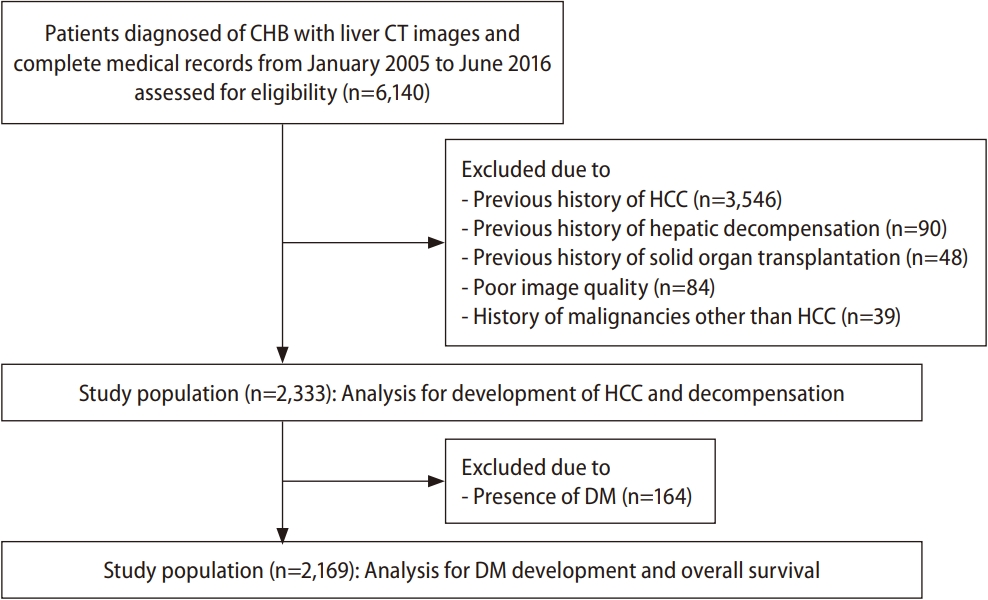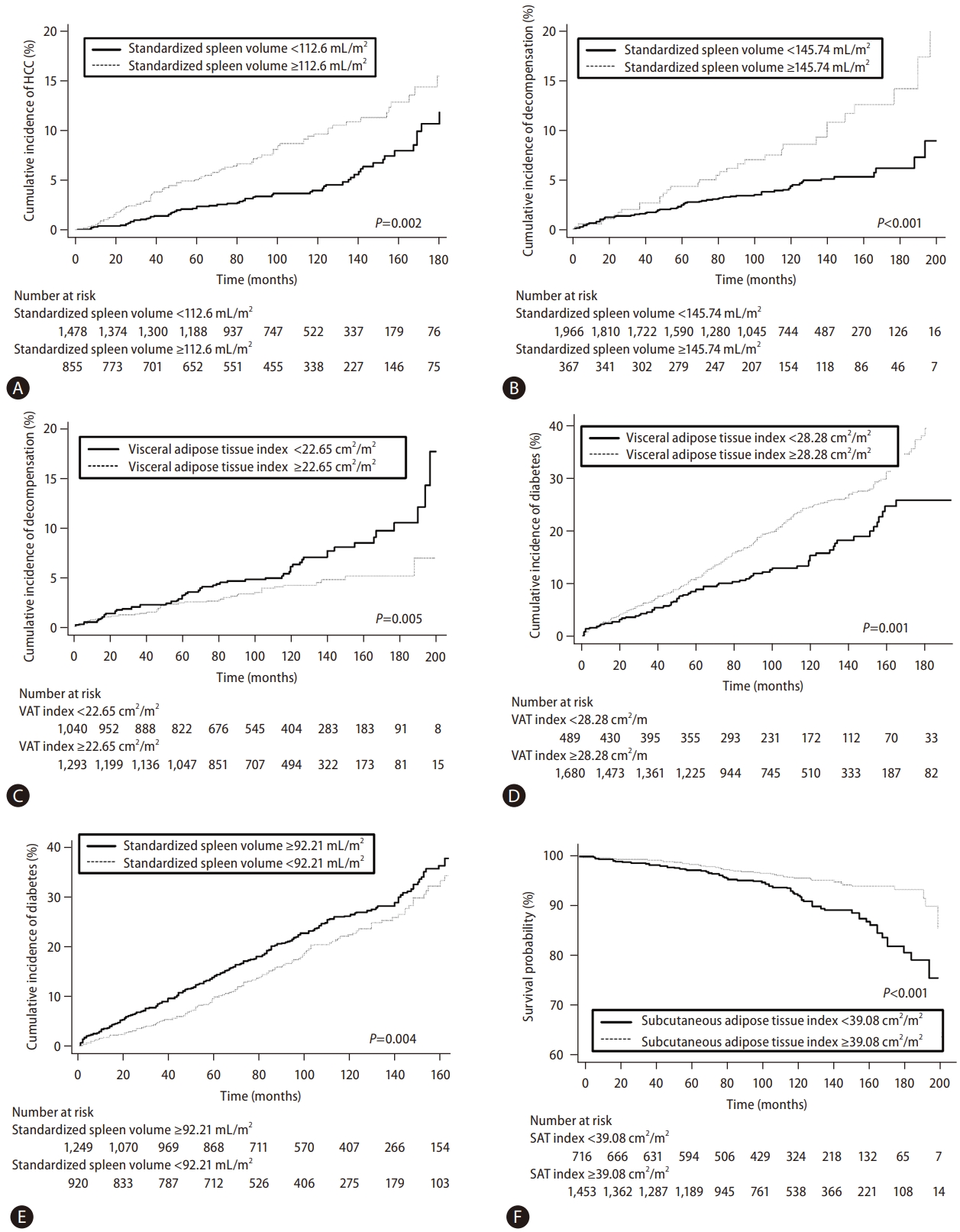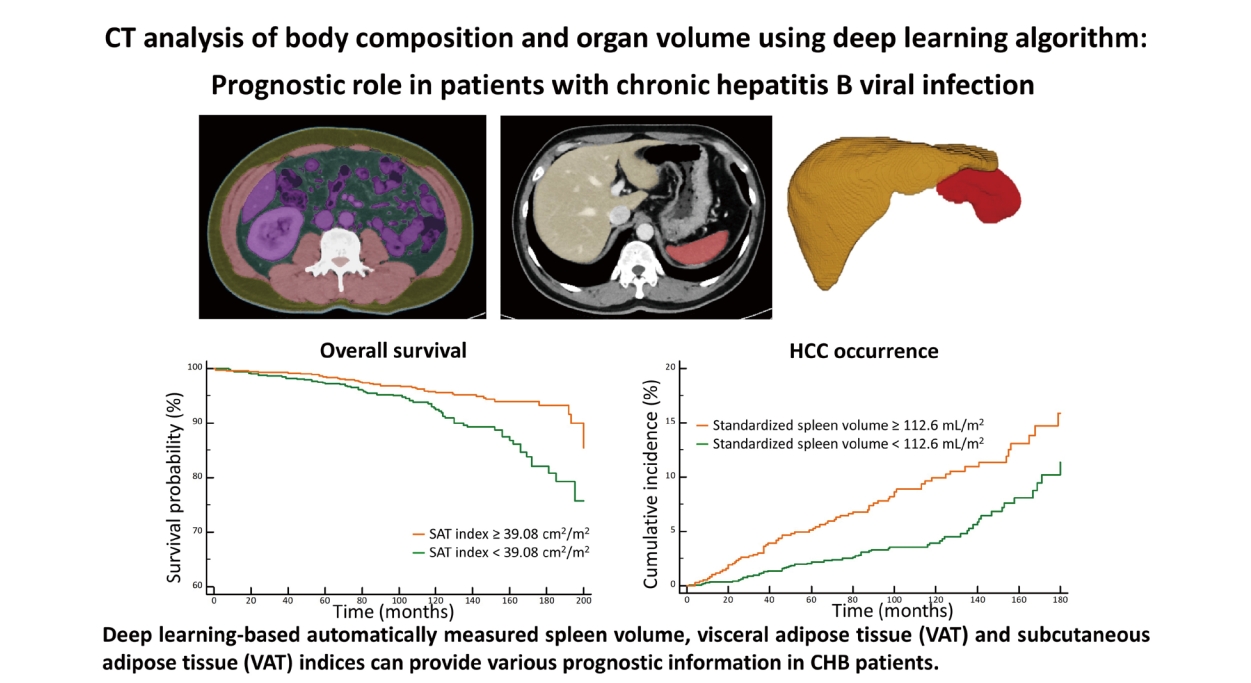| Clin Mol Hepatol > Volume 29(4); 2023 > Article |
|
ABSTRACT
Background/Aims
Methods
Results
ACKNOWLEDGMENTS
FOOTNOTES
Figure┬Ā1.

Figure┬Ā2.

Figure┬Ā3.

Table┬Ā1.
Values are presented as median (interquartile range) or number (%).
CHB, chronic hepatitis B viral infection; INR, international normalized ratio; IU, international unit; APRI, aspar tate aminotransferase-to-platelet ratio index; FIB-4, fibrosis-4 index; MELD, model for end-stage liver disease; HBeAg, hepatitis B e antigen; REACH-B, risk estimate for hepatocellular carcinoma in chronic hepatitis B.
Table┬Ā2.
| Characteristic |
Univariate |
Multivariate |
||||
|---|---|---|---|---|---|---|
| Hazard ratio | 95% CI | P-value | Hazard ratio | 95% CI | P-value | |
| Sex (female) | 0.46 | 0.31ŌĆō0.69 | <0.001 | 0.57 | 0.38ŌĆō0.87 | 0.010ŌĆĀ |
| Age (per 1 year) | 1.03 | 1.01ŌĆō1.05 | 0.001 | 1.02 | 1.01ŌĆō1.04 | 0.015ŌĆĀ |
| Body mass index (kg/m2) | 1.04 | 0.99ŌĆō1.08 | 0.108 | |||
| Antiviral therapy (yes) | 1.46 | 1.05ŌĆō2.03 | 0.024 | 0.95 | 0.65ŌĆō1.38 | 0.785 |
| HBeAg (positive) | 1.16 | 0.79ŌĆō1.70 | 0.458 | |||
| Alanine aminotransferase (IU/L) | 1.00 | 0.99ŌĆō1.01 | 0.518 | |||
| Albumin (g/L) | 0.63 | 0.50ŌĆō0.80 | <0.001 | 0.77 | 0.59ŌĆō1.02 | 0.068 |
| Total bilirubin (mg/dL) | 1.01 | 0.90ŌĆō1.12 | 0.912 | |||
| PT-INR | 1.00 | 0.94ŌĆō1.07 | 0.982 | |||
| Platelet count (K/mm3) | 0.99 | 0.99ŌĆō0.99 | <0.001 | 0.99 | 0.99ŌĆō0.99 | 0.002ŌĆĀ |
| AFP (ng/mL) | 1.00 | 0.99ŌĆō1.01 | 0.157 | |||
| Standardized liver volume (mL/m2) | 0.99 | 0.99ŌĆō1.00 | 0.099 | |||
| Standardized spleen volume Ōēź112.6 mL/m2 | 1.92 | 1.36ŌĆō2.69 | <0.001 | 1.71 | 1.21ŌĆō2.42 | 0.002ŌĆĀ |
| Skeletal muscle index (cm2/m2) | 1.00 | 0.99ŌĆō1.01 | 0.901 | |||
| Visceral adipose tissue index (cm2/m2) | 1.00 | 0.99ŌĆō1.01 | 0.709 | |||
| Subcutaneous adipose tissue index (cm2/m2) | 0.99 | 0.99ŌĆō1.00 | 0.016 | 1.00 | 0.99ŌĆō1.01 | 0.835 |
| APRI | 1.00 | 0.97ŌĆō1.03 | 0.982 | |||
| FIB-4 | 1.00 | 0.99ŌĆō1.01 | 0.923 | |||
| REACH-B | 1.26 | 1.20ŌĆō1.33 | <0.001 | 1.20 | 1.12ŌĆō1.28 | <0.001ŌĆĀ |
| MELD | 1.07 | 1.02ŌĆō1.12 | 0.003 | 1.00 | 0.95ŌĆō1.06 | 0.895 |
CHB, chronic hepatitis B viral infection; HCC, hepatocellular carcinoma; CI, confidence interval; HBeAg, hepatitis B e antigen; PT-INR, prothrombin time international normalized ratio; AFP, alpha fetoprotein; APRI, aspartate aminotransferase-to-platelet ratio index; FIB-4, fibrosis-4 index; REACH-B, risk estimate for hepatocellular carcinoma in chronic hepatitis B; MELD, model for end-stage liver disease.
Table┬Ā3.
| Characteristic |
Univariate |
Multivariate |
||||
|---|---|---|---|---|---|---|
| Hazard ratio | 95% CI | P-value | Hazard ratio | 95% CI | P-value | |
| Sex (female) | 1.09 | 0.75ŌĆō1.60 | 0.647 | |||
| Age (per 1 year) | 1.06 | 1.04ŌĆō1.08 | <0.001 | 1.06 | 1.04ŌĆō1.08 | <0.001ŌĆĀ |
| Body mass index (kg/m2) | 1.01 | 0.98ŌĆō1.05 | 0.493 | |||
| Antiviral therapy (yes) | 1.14 | 0.79ŌĆō1.66 | 0.488 | |||
| HBeAg (positive) | 1.21 | 0.78ŌĆō1.88 | 0.397 | |||
| Alanine aminotransferase (IU/L) | 1.00 | 0.99ŌĆō1.01 | 0.369 | |||
| Albumin (g/L) | 0.52 | 0.42ŌĆō0.64 | <0.001 | 0.59 | 0.45ŌĆō0.77 | <0.001ŌĆĀ |
| Total bilirubin (mg/dL) | 0.91 | 0.69ŌĆō1.19 | 0.469 | |||
| PT-INR | 1.00 | 0.91ŌĆō1.10 | 0.967 | |||
| Platelet count (K/mm3) | 1.00 | 0.99ŌĆō1.01 | 0.115 | |||
| AFP (ng/mL) | 1.00 | 0.99ŌĆō1.01 | 0.245 | |||
| Standardized liver volume (mL/m2) | 1.00 | 0.99ŌĆō1.00 | 0.383 | |||
| Standardized spleen volume Ōēź145.7 mL/m2 | 2.14 | 1.39ŌĆō3.27 | <0.001 | 2.34 | 1.51ŌĆō3.63 | <0.001ŌĆĀ |
| Skeletal muscle index (cm2/m2) | 1.00 | 0.99ŌĆō1.01 | 0.780 | |||
| Visceral adipose tissue index Ōēź22.65 cm2/m2 | 0.61 | 0.41ŌĆō0.90 | 0.013 | 0.57 | 0.38ŌĆō0.84 | 0.005ŌĆĀ |
| Subcutaneous adipose tissue index (cm2/m2) | 0.99 | 0.99ŌĆō1.00 | 0.120 | |||
| APRI | 0.99 | 0.92ŌĆō1.05 | 0.660 | |||
| FIB-4 | 1.00 | 0.98ŌĆō1.01 | 0.855 | |||
| REACH-B | 1.14 | 1.07ŌĆō1.21 | <0.001 | 1.05 | 0.98ŌĆō1.12 | 0.144 |
| MELD | 1.07 | 1.02ŌĆō1.12 | 0.008 | 1.02 | 0.96ŌĆō1.07 | 0.564 |
CHB, chronic hepatitis B viral infection; CI, confidence interval; HBeAg, hepatitis B e antigen; PT-INR, prothrombin time international normalized ratio; AFP, alpha fetoprotein; APRI, aspartate aminotransferase-to-platelet ratio index; FIB-4, fibrosis-4 index; REACH-B, risk estimate for hepatocellular carcinoma in chronic hepatitis B; MELD, model for end-stage liver disease.
Table┬Ā4.
| Characteristic |
Univariate |
Multivariate |
||||
|---|---|---|---|---|---|---|
| Hazard ratio | 95% CI | P-value | Hazard ratio | 95% CI | P-value | |
| Sex (female) | 0.70 | 0.57ŌĆō0.85 | <0.001 | 0.73 | 0.56ŌĆō0.95 | 0.017ŌĆĀ |
| Age (per 1 year) | 1.04 | 1.03ŌĆō1.05 | <0.001 | 1.05 | 1.04ŌĆō1.06 | <0.001ŌĆĀ |
| Body mass index (kg/m2) | 1.01 | 0.99ŌĆō1.03 | 0.211 | |||
| Antiviral therapy (yes) | 1.14 | 0.94ŌĆō1.37 | 0.189 | |||
| Alanine aminotransferase (IU/L) | 1.00 | 0.99ŌĆō1.01 | 0.604 | |||
| Albumin (g/L) | 0.80 | 0.67ŌĆō0.95 | 0.013 | 0.79 | 0.65ŌĆō0.95 | 0.014ŌĆĀ |
| Total bilirubin (mg/dL) | 0.98 | 0.91ŌĆō1.07 | 0.690 | |||
| PT-INR | 0.99 | 0.93ŌĆō1.06 | 0.820 | |||
| Platelet count (K/mm3) | 1.00 | 0.99ŌĆō1.01 | 0.116 | |||
| AFP (ng/mL) | 1.00 | 0.99ŌĆō1.01 | 0.431 | |||
| Standardized liver volume (mL/m2) | 1.01 | 1.01ŌĆō1.01 | 0.004 | 1.00 | 0.99ŌĆō1.01 | 0.075 |
| Standardized spleen volume Ōēź92.21 mL/m2 | 1.23 | 1.01ŌĆō1.49 | 0.040 | 1.35 | 1.10ŌĆō1.67 | 0.004ŌĆĀ |
| Skeletal muscle index (cm2/m2) | 1.00 | 0.99ŌĆō1.01 | 0.686 | |||
| Visceral adipose tissue index Ōēź28.28 cm2/m2 | 1.56 | 1.21ŌĆō2.02 | 0.001 | 1.34 | 1.13ŌĆō1.74 | 0.001ŌĆĀ |
| Subcutaneous adipose tissue index (cm2/m2) | 1.00 | 0.99ŌĆō1.01 | 0.927 | |||
| APRI | 1.00 | 0.98ŌĆō1.02 | 0.932 | |||
| FIB-4 | 0.99 | 0.99ŌĆō1.01 | 0.571 | |||
| MELD | 1.05 | 1.01ŌĆō1.09 | 0.007 | 1.03 | 0.99ŌĆō1.07 | 0.176 |
Table┬Ā5.
| Characteristic |
Univariate |
Multivariate |
||||
|---|---|---|---|---|---|---|
| Hazard ratio | 95% CI | P-value | Hazard ratio | 95% CI | P-value | |
| Sex (female) | 0.68 | 0.46ŌĆō1.01 | 0.053 | |||
| Age (per 1 year) | 1.09 | 1.07ŌĆō1.12 | <0.001 | 1.09 | 1.07ŌĆō1.11 | <0.001ŌĆĀ |
| Body mass index (kg/m2) | 0.97 | 0.94ŌĆō0.99 | 0.015 | |||
| Antiviral therapy (yes) | 1.00 | 0.70ŌĆō1.43 | 0.999 | |||
| Alanine aminotransferase (IU/L) | 1.00 | 1.00ŌĆō1.01 | 0.085 | |||
| Albumin (g/L) | 0.48 | 0.40ŌĆō0.58 | <0.001 | 0.51 | 0.40ŌĆō0.65 | <0.001ŌĆĀ |
| Total bilirubin (mg/dL) | 1.06 | 0.99ŌĆō1.15 | 0.115 | |||
| PT-INR | 1.00 | 0.93ŌĆō1.08 | 0.935 | |||
| Platelet count (K/mm3) | 1.00 | 0.99ŌĆō1.01 | 0.784 | |||
| AFP (ng/mL) | 1.00 | 1.00ŌĆō1.01 | 0.073 | |||
| Standardized liver volume (mL/m2) | 1.00 | 0.99ŌĆō1.00 | 0.737 | |||
| Standardized spleen volume | 1.00 | 0.99ŌĆō1.01 | 0.148 | |||
| Skeletal muscle index (cm2/m2) | 0.99 | 0.98ŌĆō1.01 | 0.361 | |||
| Visceral adipose tissue index (cm2/m2) | 0.99 | 0.99ŌĆō1.00 | 0.678 | |||
| Subcutaneous adipose tissue index Ōēź39.08 cm2/m2 | 0.46 | 0.32ŌĆō0.66 | <0.001 | 0.49 | 0.34ŌĆō0.70 | <0.001ŌĆĀ |
| APRI | 1.01 | 0.99ŌĆō1.03 | 0.269 | |||
| FIB-4 | 1.00 | 0.99ŌĆō1.01 | 0.911 | |||
| MELD | 1.12 | 1.08ŌĆō1.17 | <0.001 | 1.09 | 1.04ŌĆō1.14 | <0.001ŌĆĀ |
REFERENCES
-
METRICS

-
- 0 Crossref
- 1 Scopus
- 2,680 View
- 117 Download
- ORCID iDs
-
Dong Ho Lee

https://orcid.org/0000-0001-8983-851X - Related articles




 PDF Links
PDF Links PubReader
PubReader ePub Link
ePub Link Full text via DOI
Full text via DOI Download Citation
Download Citation Print
Print



